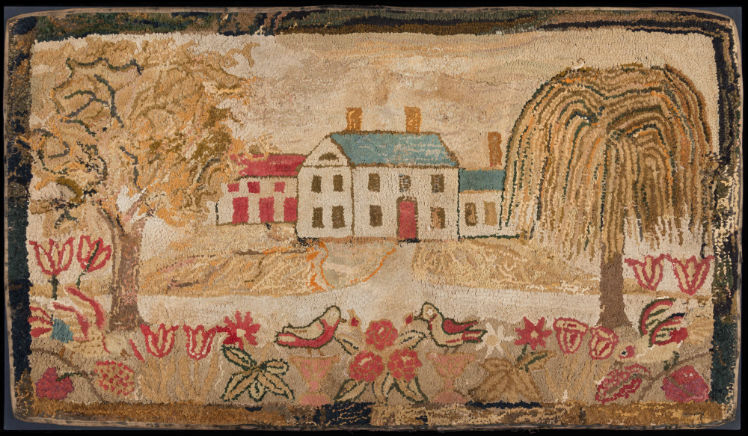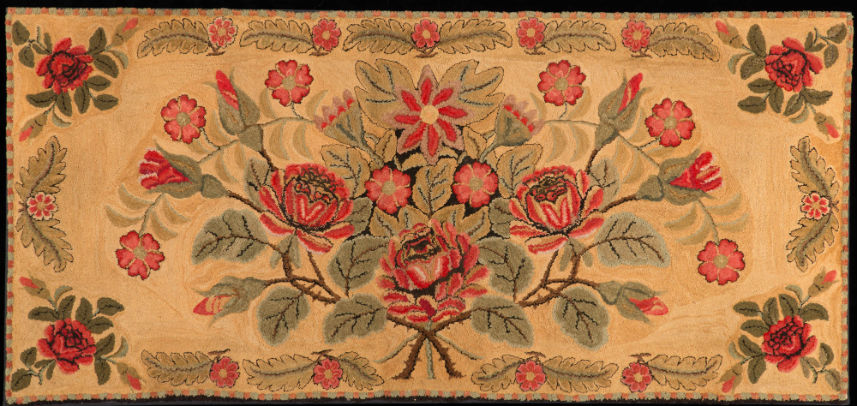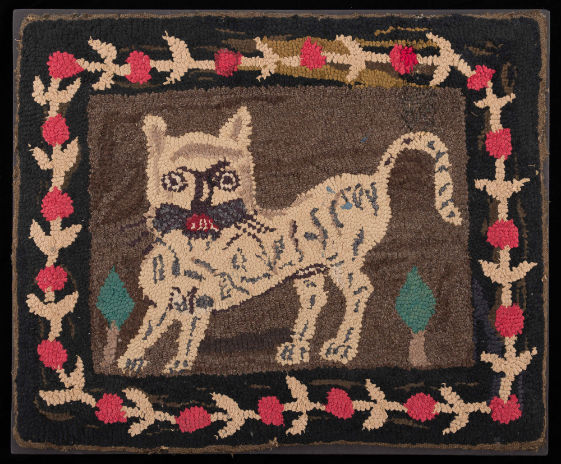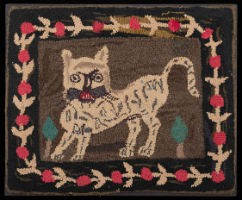
WILLIAMSBURG, Va. – Spanning more than a century of rug making, the craft of creating nonwoven rugs will be in the spotlight at the Abby Aldrich Rockefeller Folk Art Museum, one of the Art Museums of Colonial Williamsburg, when “Folk Art Underfoot: American Hooked Rugs,” an exhibition of 14 exquisite examples of sewn and hooked rugs opens Sept. 15 to remain on view through Sept. 7, 2020.
The rugs, some of which have never before been on public view, are on loan from the collection of Joseph and Linda Caputo of Maine, along with visual documentation and a video that shows the rug hooking technique. These simple objects that express the unique artistry of their makers and were created for both use and enjoyment are considered in the best tradition of American folk art.
“This work of 19th-century artisans, most of them nameless to us today, cannot be overlooked,” said Mitchell B. Reiss, president and CEO of the Colonial Williamsburg Foundation. “Their creativity is woven through our American fabric, and we are proud to be able to share with our visitors these unique rugs as another way to explore our shared history.”
Originally created by rural housewives for use as floor coverings, hooked rugs also provided color, pattern and warmth to country homes. Rug making gave housewives with no academic art training a way to create an everyday household object with decorative interest and beauty. Sewn rugs grew out of an earlier needlework tradition, which included sampler making and crewel wool embroidery. Sewn rugs include yarn sewn and shirred. Rug hooking techniques originated in Maine and grew from their 19th-century origins to a national activity.
Not only are the rugs in “Folk Art Underfoot” exceptional examples of their craft, they have also helped to reveal new findings through research conducted in Colonial Williamsburg’s state-of-the-art textile laboratory about the materials on which the rugs were made. Traditionally, it was believed that early sewn and hooked rugs were worked on ground fabrics of linen with wool yarn or fabric strip piles. Microscopic analysis in the lab revealed, however, that most of the grounds in the early rugs in this exhibition are cotton, not linen. Some of the piles were created with cotton fabric strips in addition to wool.
In addition to learning about the materials used to create a rug, visitors to Folk Art Underfoot can see examples of yarn-sewn, shirred and bias-shirred, and bundled or patch-shirred sewn rugs; signed and dated examples of hooked rugs; rugs with design motifs that echo those found in other home furnishings; rugs made from patterns; as well as a section focused on the distinct style of hooked rugs that originated in Waldoboro, Maine, a ship-building community originally settled by German immigrants.

Among the exhibition’s highlights is a bias-shirred hearth rug, made of wool on cotton in New England (probably Maine), circa 1830. This style of rug is created in an appliqué technique using fabric strips cut on a bias (a 45-degree angle to the fabric’s warp and weft) and stitched lengthwise down the center of the strip to a ground fabric with thread. The strips are closely sewn, side by side, with the edges folded up to create the pile, creating a wavy look in the design. Dating from 1820 to 1840, bias shirring is the earliest and most challenging of the shirring techniques. This example’s elongated shape and one-way design suggest that it was intended as a hearth rug to ornament a fireplace not in use during the summer months. Because of its large size (32¼ inches high by 68½ inches wide), the rug was worked in sections and then attached to the cotton foundation.
Another excellent example of a sewn rug is a wool-on-cotton, bundled-shirred furniture mat, also probably from Maine and made circa 1850-1875. This type of shirred rug is made using small, circular patches of scrap fabric that have been sewn together at their centers and then stitched to a ground fabric to create a geometric pattern. Because this technique produces a bulky pile, making fine details is difficult. This example, which is often referred to as a button or penny rug (the circular patches used to create it are about the same size as a button or coin), used 1¾-inch-diameter wool patches. Its small size (18 inches high by 27 inches wide) suggests it may have been used on a table or chest of drawers for ornamentation and protection.
Hooked rugs, unlike their sewn counterparts, are created by pulling loops of yarn or fabric strips through a woven ground fabric such as linen, burlap or cotton. A crochet-type hook mounted in a handle is used to pull the loops from the underside of the ground fabric to the surface. The widths of the fabric strips can vary and the created looped pile can be left uncut or cut. One particularly eye-catching example in “Folk Art Underfoot: American Hooked Rugs” was made in New England, probably Maine, between 1875 and 1900 of wool and cotton on burlap (jute). While commercial rug patterns featuring lions were popular during this time, no pattern has been identified for the feisty feline captured in this rug. The lion’s stance is similar to the lion image found on woven coverlets created earlier in the century.

Sewn and hooked rugs were historically seldom signed so we will never know the makers of most of them. It is unusual to find a rug with a date or a place name, therefore “Folk Art Underfoot” offers a rare opportunity to see three signed and dated examples. One exceptional piece is attributed to Lucy Trask Barnard (1800-1896) who created hooked rugs and quilts throughout much of her adult life. She was the second daughter of Amos and Lucy Park Trask and wife of Silas Barnard, a well-educated surveyor of Dixfield, Maine. Lucy Trask Barnard, a life-long resident of Dixfield, busy housewife, teacher and mother of eight children, found time to create at least six hooked rugs, four of which feature a large, white house on a hill with attached outbuildings such as this example made circa 1850 of wool and cotton on linen. Red doors and similar trees also relate the rugs, which display a sophisticated awareness of perspective through the use of oversized flowers in the foreground and two-sided buildings. Landscapes such as these require greater skill and appear less frequently than floral and geometric patterns. The weeping willow tree on this rug is unusual and may have been inspired by the mourning pictures popularly created by girls in the early 19th century.
“Just as early hooked and sewn rugs were created to be used and enjoyed by the makers, their family and friends, the rug-making tradition continues today to be an important expression of American ingenuity and imagination,” said Kimberly Smith Ivey, Colonial Williamsburg’s senior curator of textiles. “With their uninhibited designs and perspective, and bold and unconventional use of color, hooked and sewn rugs are actually pictures that express a desire to make common everyday objects beautiful.”
Joseph and Linda Caputo have been inspired by the warmth and beauty of American hooked and sewn rugs for years. They enjoy living among their collection as well as sharing their objects with broader audiences such as those who visit the Art Museums of Colonial Williamsburg.
This exhibition is made possible through the generosity of Thomas L. and Nancy S. Baker and Cynthia and Larry Norwood.


